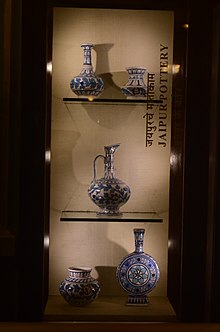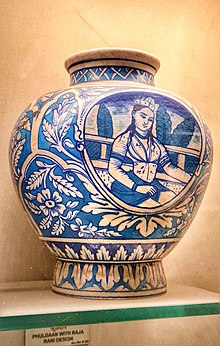
Delftware or Delft pottery, also known as Delft Blue or as delf, is a general term now used for Dutch tin-glazed earthenware, a form of faience. Most of it is blue and white pottery, and the city of Delft in the Netherlands was the major centre of production, but the term covers wares with other colours, and made elsewhere. It is also used for similar pottery, English delftware.

Jaipur is the capital and the largest city of the north-western Indian state of Rajasthan. As of 2011, the city has a population of 3.1 million, making it the tenth most populous city in the country. Located 268 km from the national capital New Delhi, Jaipur is also known as the Pink City due to the dominant color scheme of its buildings in old city.

Terracotta, also known as terra cotta or terra-cotta, is a term used in some contexts for earthenware. It is a clay-based non-vitreous ceramic, fired at relatively low temperatures.

Shekhawati is a semi-arid historical region located in the northeast part of Rajasthan, India. The region was ruled by Shekhawat Rajputs. Shekhawati is located in North Rajasthan, comprising the districts of Neem Ka Thana, Jhunjhunu, Sikar that lies to the west of the Aravalis and Churu. It is bounded on the northwest by the Bagar region, on the northeast by Haryana, on the east by Mewat, on the southeast by Dhundhar, on the south by Ajmer, and on the southwest by the Marwar region. Its area is 13,784 square kilometers.

Chhatri are semi-open, elevated, dome-shaped pavilions used as an element in Indo-Islamic architecture and Indian architecture. They are most commonly square, octagonal, and round. Originating as a canopy above tombs, they largely serve as decorative elements as opposed to functional elements. The earliest examples of chhatri being used in the Indian Subcontinent were found in the Shrine of Ibrahim in Bhadreswar, constructed between 1159 and 1175 AD.

Phulkari refers to the folk embroidery of the Punjab region and Gulkari of Sindh in South Asia.
Kripal Singh Shekhawat (1922-2008) was a renowned craftsman and ceramist of India. He was famous for his skills in Blue Pottery of Jaipur and is credited for the revival of that art in India.

Pottery in the Indian subcontinent has an ancient history and is one of the most tangible and iconic elements of Indian art. Evidence of pottery has been found in the early settlements of Lahuradewa and later the Indus Valley Civilisation. Today, it is a cultural art that is still practiced extensively in the subcontinent. Until recent times all Indian pottery has been earthenware, including terracotta.

Fritware, also known as stone-paste, is a type of pottery in which frit is added to clay to reduce its fusion temperature. The mixture may include quartz or other siliceous material. An organic compound such as gum or glue may be added for binding. The resulting mixture can be fired at a lower temperature than clay alone. A glaze is then applied on the surface.

Talavera pottery is a Mexican and Spanish pottery tradition from Talavera de la Reina, in Spain. In 2019, it was included in UNESCO's Representative List of the Intangible Cultural Heritage of Humanity.
Ram Gopal Vijayvargiya (1905–2003) was an Indian painter. He was also a poet and a writer.

The culture of Rajasthan includes many artistic traditions that reflect the ancient Indian way of life. Rajasthan is also called the "Land of Kings". It has many tourist attractions and facilities for tourists. This historical state of India attracts tourists and vacationers with its rich culture, tradition, heritage and monuments. It also has some wildlife sanctuaries and national parks.

Chinese influences on Islamic pottery cover a period starting from at least the 8th century CE to the 19th century. The influence of Chinese ceramics on Islamic pottery has to be viewed in the broader context of the considerable importance of Chinese culture on Islamic arts in general.

Ceramics in Mexico date back thousands of years before the Pre-Columbian period, when ceramic arts and pottery crafts developed with the first advanced civilizations and cultures of Mesoamerica. With one exception, pre-Hispanic wares were not glazed, but rather burnished and painted with colored fine clay slips. The potter's wheel was unknown as well; pieces were shaped by molding, coiling and other methods,

The Albert Hall Museum in Jaipur is the oldest museum of the state and functions as the state museum of Rajasthan, India. The building is situated in Ram Niwas garden outside the city wall opposite New gate and is a fine example of Indo-Saracenic architecture. It is also called the Government Central Museum. It was considered one of the best 19th century museums for the variety of its collections. It was renovated in 2008 and reopened as one of the most advanced museums in India.

Sawai Padmanabh Singh is the head of the royal family of the former Jaipur State from Kachhwaha Rajput clan, and a distinguished Indian polo player.

Ceramics of Jalisco, Mexico has a history that extends far back in the pre Hispanic period, but modern production is the result of techniques introduced by the Spanish during the colonial period and the introduction of high-fire production in the 1950s and 1960s by Jorge Wilmot and Ken Edwards. Today various types of traditional ceramics such as bruñido, canelo and petatillo are still made, along with high fire types like stoneware, with traditional and nontraditional decorative motifs. The two main ceramics centers are Tlaquepaque and Tonalá, with a wide variety of products such as cookware, plates, bowls, piggy banks and many types of figures.
Anokhi is an Indian retailer based in Jaipur, Rajasthan, which retails textiles, clothing, furnishings, and accessories, made with traditional Indian motifs and techniques. It was founded in 1970 by husband and wife, John and Faith Singh, with a focus on reviving traditional Rajasthani hand-block or woodcut printing techniques, and the use of natural vegetable dyes. Anokhi works directly with Rajasthani craftspeople, and retails through its 25 stores in India and a few stockists in Europe and the United States.

The pottery collection of the Albert Hall Museum in Jaipur, India, is a diverse 19th-century collection. The collection represents a wide range of crafts, techniques, and regions. The display includes unglazed vessels with ornamental decoration. The pottery techniques on display include burnished, lacquered, slip-painted, incised wares, and glazed pottery. The museum has representative pieces of Indian craftsmanship and other international pottery styles.

Chandramani Singh was an Indian art historian, textile expert, writer and a museum archivist based in Jaipur, Rajasthan. As a writer, Singh had edited and authored numerous works on museums, culture, and heritage. Her notable works include Jaipur Rajya ka Itihas, Art Treasures of Rajasthan, Performing Arts of Rajasthan: Lok-Rang, and Protected Monuments of Rajasthan among others. She was associated with Banaras Hindu University, the Sawai Mansingh II City Palace Museum and Jawahar Kala Kendra. She had also worked for the restoration of the Jaigarh Fort, Jaipur. She died in 2022 after a prolonged illness.































